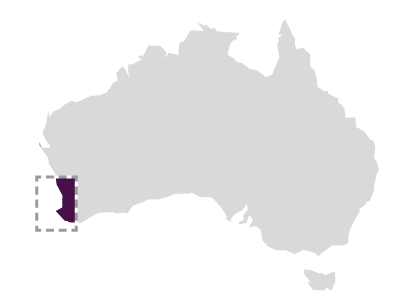Elizabeth (1843/11/17)
Bunbury, Koombana Bay, North Beach

Port of Building: Calcutta
Year built: 1831
Port of Registration: Fremantle
Rig Type: Schooner
Hull: Wood
Length: 62 ft (18.9 m)
Breadth: 18 ft (5.49 m)
Depth: 9 ft (2.74 m)
Tonnage: 100
Port from: Bunbury
Port to: Bunbury
Date lost: 17 November 1843
Location: Koombana Bay
Chart Number: Aus 115 & WA 50976
Protection: The site when found will be protected under the general provisions of the Historic Shipwrecks Act 1976
Significance criteria: 1 & 4
THE VESSEL
Built in Calcutta of teak and launched in January 1832 the Elizabeth was purchased by L. & W. Samson for £1 600. It had a square stern and a female bust figurehead. In 1841 it was sheathed with copper, but the following year a Lloyd’s surveyor noted that the schooner was not in particularly good condition. The schooner had been blown ashore at Fremantle in October 1839, but was refloated. The vessel was insured for £800 when it was anchored in Koombana Bay, under the command of Captain James. It was taking aboard material salvaged from the American whaler North America, which had been wrecked some seven months earlier and was being broken up to obtain the timbers. On board the Elizabeth were 32 casks of oil belonging to Luke Samuel Leake, together with some of the timbers from the whaler and many bundles of barrel staves, known as shooks, the property of Captain Daniel Scott who was the purchaser of the wreck of the North America. The Elizabeth’s top-gallant mast had not been lowered, a practice normally carried out by vessels when at anchor to reduce windage should a gale arise.
THE LOSS
The Elizabeth was anchored when the wind increased and on 15 November 1843 the schooner parted its port anchor cable. The following evening the wind had turned to a gale from the north-west, increasing during the night until the morning of Friday 17 November, when the vessel’s starboard cable parted. Dragging the replacement port anchor, the schooner drove ashore at 2.00 p.m. It struck heavily, and then heeled over on to its beam ends with the deck facing the seas. The deck, which had been partly lifted by the casks of oil floating in the hold, was soon washed away. This caused the main mast to fall. The whole bottom of the hull on the port side was also smashed and then washed away. The crew got ashore by rope, but almost everything aboard the vessel, including the ship’s papers and the chronometer, was lost.
The barque Parkfield (Captain Whiteside) recently arrived from Sydney was anchored nearby, and its crew had quickly lowered a boat to go to the aid of the Elizabeth, but by the time they got near the schooner was in the surf zone and help by boat was impossible.
INITIAL SALVAGE
The advice sent by Marshall Waller Clifton to the owners in Fremantle was that the only items salvaged from the wreck of the Elizabeth were18 or 20 casks of oil which had washed on shore. The remainder of the casks still in the hold were expected to be stove in (Gazette, 25 November 1843). It is probable that many of Daniel Scott’s barrel staves were washed ashore after the Elizabeth broke up, and were therefore salvaged.
SITE LOCATION
This wreck of the Elizabeth has not been found, but as it was working near the North America (1843) it may be expected to be reasonably close to that wreck.
STATEMENT OF SIGNIFICANCE
HISTORIC (1)
The Elizabeth was used by L & W Samson for whaling, and during mid-1839 fished in the Geographe Bay area, striking eight whales but only taking four. This was one of the earliest whaling ventures carried out by settlers in Western Australia.
The Parkfield had brought out the Chief Commissioner of the West Australian Company, Marshall Waller Clifton, and the first body of settlers for Australind in March 1841.
ARCHAEOLOGICAL (4)
When found the wreck of the Elizabeth, built in India, will provide an interesting comparison with schooners built locally at about the same time.
REFERENCES
Bolton, G., Vose, H., Watson, A. & Lewis, S., (eds), 1992, The Wollaston Journals Volume 2, 1842–1844. University of Western Australia Press, Nedlands.
Broeze, F.J.A., 1981, Western Australia until 1869: The Maritime Perspective, Part 1. Early Days: Journal and Proceedings of the Royal Western Australian Historical Society, 8.5.
Dickson, R., 2007, The History of the Whalers on the South Coast of New Holland from 1800–1888. Hesperian Press, Victoria Park.
Erickson, R., 1979, Dictionary of Western Australians: Free: 1850–1968, Volume 3. University of Western Australia Press, Nedlands.
Henderson, G., 2007, Unfinished Voyages: Western Australian Shipwrecks 1622–1850. University of Western Australia Press, Crawley.
McCarthy, M., 1982, Koombanah Bay wrecks: an investigation of the wrecks in the bay, for the State Electricity Commission of Western Australia. Report—Department of Maritime Archaeology, Western Australian Maritime Museum, No. 19.
The Perth Gazette and Western Australian Journal, 25 November 1843: 2a-b.
The schooner Elizabeth was built in Calcutta in 1831, and was bought by L. and W. Samson of Fremantle for trade between the Eastern Australian colonies and Asian ports. The Elizabeth was wrecked on the North Beach of Koombana Bay during a north-westerly gale.
Ship Built
Owner L. and W. Samson of Fremantle
Country Built India
Port Built Calcutta
When Built 1831
Ship Lost
Grouped Region South-West-Coast
Sinking Blown ashore in gale
When Lost 1843/11/17
Where Lost Bunbury, Koombana Bay, North Beach
Port From Rio (Kepulauan Riau)
Port To Fremantle
Cargo 32 casks whale oil (Mr Leake’s oil), Captain Scott’s shooks (barrel staves) from wreck of North America
Ship Details
Engine N
Length 18.90
Beam 5.50
TONA 100.00
Draft 2.70
Museum Reference
Unique Number 140
Sunk Code Wrecked and sunk
File Number 405/71
Protected Protected Federal
Found N
Inspected N
Confidential NO